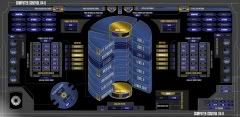|
Written by Vadm. Uvar
|
|
Sunday, 23 January 2011 |
|
Page 2 of 3 Propulsion systems 
WARP PROPULSION SYSTEM
Designed specifically for the Sovereign-class starship, the General Electric Class 8 M/ARA drive and power system was a first for Starfleet. Compared to other starships of similar size and mass, the Class 8 would at first appear to be quite over-powered for the Sovereign, but this is not so. Originally equipped with a more standard Class 6, the inability of the reactor to produce sufficient power was perhaps the primary reason for the initial failing of the prototype Sovereign during trail runs. High-power devices, such as the enhanced deflector system, sensor pallets, Type-XII phaser arrays and Regenerative Shielding were subsequently removed from the U.S.S. Monarchy's construction plans and replaced with less power-intensive units. In comparison, however, the U.S.S. Ark Royal (later Enterprise-E) never left spacedock without the Class 8 power plant.
A breakthrough design came about with the advent of the Class 7 warp reactor during the Defiant Class Project, which makes use of four-lobed magnetic constriction segment columns that allow for additional reactant streams to surround the primary stream that travels down the center of the magnetic constrictor columns. Advances in pressure vessel construction and compact reactor injector nozzles made the Class 8 reactor a reality, with a six-lobed design that allowed for a total of seven reactant streams of both matter and antimatter to collide in the dilithium articulation chamber, resulting in the most powerful starship-grade reactor output to date. The matter/antimatter reactor assembly spans 14 decks with the dilithium chamber and plasma transfer conduits located on the second level of Main Engineering.
Another large advancement utilized in the development of the warp propulsion system was the utilization of a rotatable dilithium articulation chamber within the warp core, where the matter and antimatter reactants are combined to create the high-energy warp plasma needed to power the engine nacelles, as well as shipboard systems through the use of EPS power taps. Computer-controlled rotation of the frame allows for manipulation of the manner in which the reactants meet, allowing for further control of the warp plasma into a "cleaner" power source. Redesigned verterium cortenide components within each pair of warp field coils is then able to use the warp plasma to generate a more energy-efficient subspace field with less particle waste products and stresses that were found in older propulsion systems to damage subspace. After the fleet-wide installation of this new variable warp geometry system, Starfleet was able to remove the so-called "Warp Speed Limit" of Warp 5, established in 2370 after the discovery of pollution by Dr. Serova in the Hekaras Corridor. Pursuant to Starfleet Command Directive 12856.A, all starships traveling within Federation space are required to receive engine upgrades that prevent the further pollution of subspace by 2380. The successful testing of the new warp propulsion system on the re-launched U.S.S. Sovereign has allowed for these upgrades to be made to her sister ships, allowing for the class to finally meet its full potential in 2373. Unfortunately, due to the intense power requirements of the enhanced sensor and navigation deflector systems, the Sovereign is unable to reach a higher maximum 12-hour speed than Warp 9.7. Type: General Electric Class 8 Standard Matter/Anti-Matter Reaction Drive, developed by General Electric Propulsion Laboratories. Information on this Warp Drive can be found in any Starfleet Library or Omnipedia. Normal Cruising Speed: Warp 7 Maximum Cruising Speed: Warp 9.7 for 12 hours IMPULSE PROPULSION SYSTEM
On any other Starship, the standard Sovereign class Impulse Engines would be rated ‘excessive’, providing thrust far in excess of the highest estimated needs. So great is the thrust provided by each individual engine that the Sovereign class has 0% loss of performance with the loss or destruction of one of her Impulse engines. Like other ships before her, Sovereign-class vessels utilizes space-time driver coils within its impulse engines to create a non-propulsive symmetrical subspace field that effectively lowers the ship's mass, making it capable of pushing the entire spacecraft using less fuel. There are two impulse engines on the ship, each operating at 25% rating for standard operations, but can boost their output to 50% for combat operations. Type: Two standard Sovereign class mass drivers developed and built by Terminal Velocity Propulsion. Output: Each engine (there are two impulse engines) can propel a Sovereign-class vessel at speeds just under .25c at “Full Impulse” and an upper ceiling of .75c at three quarters the speed of light. Generally, Starfleet Vessels are restricted to .25c speeds to avoid the more dramatic time dilation effects of higher relativistic speeds. However, such restrictions can be overridden at the behest of the ship’s captain. Due to the size of the Impulse Engines found on the Sovereign class, a single engine can propel the vessel at standard operating speeds without a loss in performance or combat maneuverability. 
|
|
Last Updated ( Sunday, 23 January 2011 )
|
 Engineering
Engineering  Engineering
Engineering 

